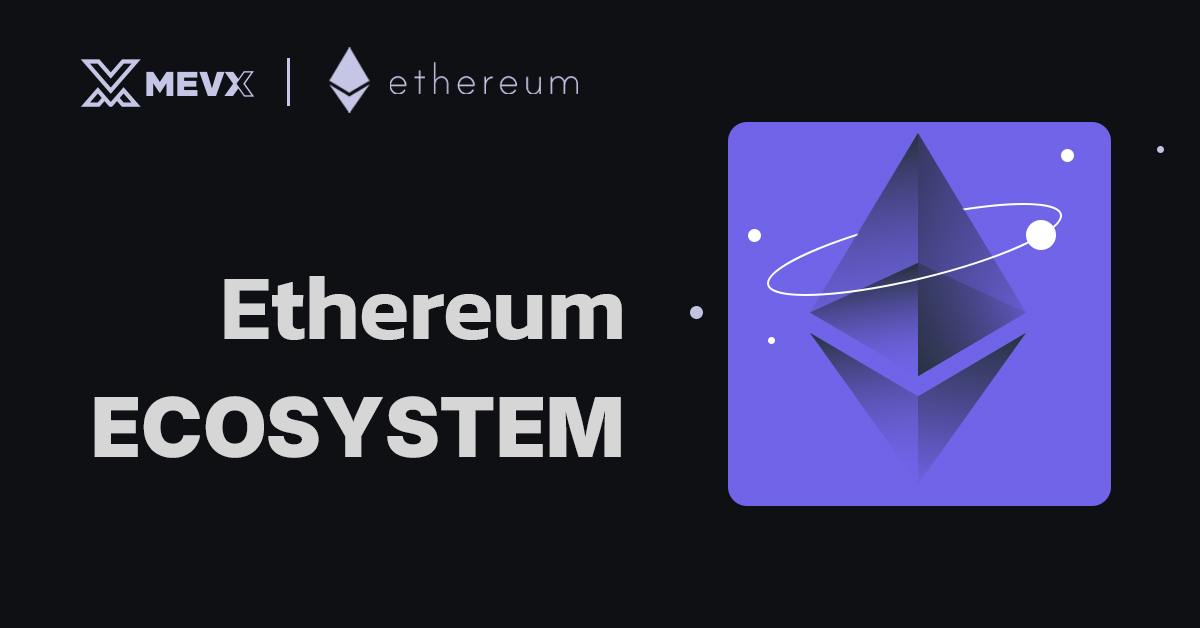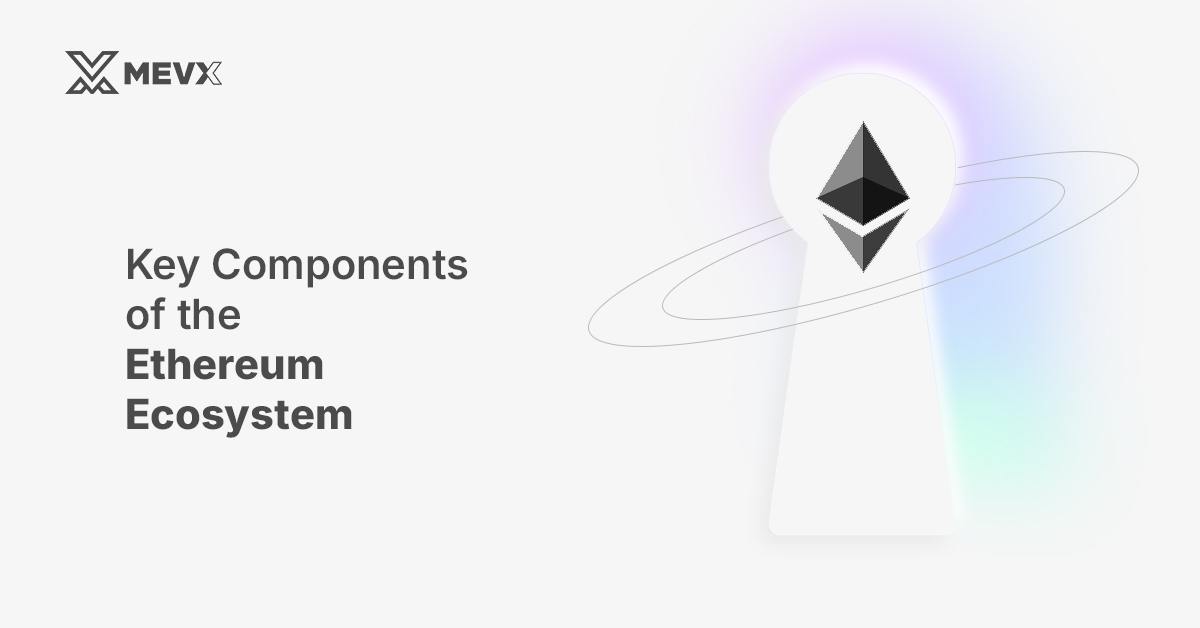Ethereum is a decentralized, self-sustaining ecosystem of technological innovation, enabling users to create an application without any intermediaries, which has given a facelift to how whole industries do business. This article explains the Ethereum ecosystem in great detail: core components, the role of smart contracts, decentralized applications (DApps), DeFi, tokens, and most importantly, Ethereum 2.0.

Ethereum Ecosystem
What is the Ethereum Ecosystem?
The Ethereum ecosystem is a broad, interrelated web of applications, financial systems, and technologies based on or using the Ethereum blockchain. In contrast to traditional financial systems and apps that rely on a centralized system of operation, Ethereum allows decentralized solutions through the use of smart contracts and distributed ledger technology. Today, Ethereum is one of the leaders in the fields of decentralized finance, non-fungible tokens, and decentralized applications.
Key Components of the Ethereum Ecosystem
The Ethereum ecosystem thrives on some mainstays that make it work and present a whole new world of versatility. Such building blocks of innovation in finance, digital assets, and more include but are not limited to the Ethereum Blockchain, smart contracts, DApps, and DeFi protocols. Combined, these provide a robust, strongly interconnected network that powers many applications without intermediaries, thus opening Ethereum to its full growth and potential for impact.

Key Components of the Ethereum Ecosystem
1. Ethereum Blockchain
Ethereum is a decentralized blockchain network that records transactions and provides developers with the capability to build applications without any central point of control. The network retains security in transaction recording while providing programmability with smart contracts.
For more details, see Ethereum: The ‘World Computer’ Transforming Blockchain and Finance
2. Smart Contracts
Smart contracts are essentially the heart and soul of Ethereum’s functionality. In simple terms, smart contracts represent self-executing contracts that have the terms of the agreement written directly into lines of code. The code then performs an action when a certain set of circumstances or conditions is met. They allow applications to run without intermediaries, thereby making processes faster, more transparent, and secure.
In the Ethereum ecosystem, smart contracts enable:
- Financial transactions without banks
- Marketplaces without intermediaries
- Voting systems without centralized oversight
These programmable agreements then form the backbone upon which decentralized applications and financial products run on Ethereum.
See What are Smart Contracts? Their Roles in the Ethereum Ecosystem
3. Decentralized Applications (DApps)
Decentralized applications are autonomously executable programs running on the Ethereum blockchain. DApps operate independently without the control of any one body; in addition, the topics of DApps include financial services, games, marketplaces, and social networks. They use smart contracts to guarantee secure, self-executing processes and rules that are transparent.
Some notable types of DApps include:
- DeFi Platforms: Many decentralized finance platforms use Uniswap, Aave, and Compound to provide lending, borrowing, and trading without banks.
- NFT Marketplaces: OpenSea and Rarible are online markets where one can buy, sell, and even trade non-fungible tokens. The most widely used blockchains to build the NFTs are Flow, Ethereum, and Binance Smart Chain.
- Gaming and Virtual Worlds: Ethereum also facilitates virtual worlds such as Decentraland and games like Axie Infinity, where players can get rewards or make in-game items tradable as NFTs.
For more information, see A Guide to DApps on the Ethereum Blockchain
4. Decentralized Finance (DeFi)
DeFi is the single largest on-chain innovation of the Ethereum ecosystem. DeFi applications are recreating traditional financial services such as lending borrowing, and even trading, in a decentralized system without banks or any other financial middlemen. Instead, DeFi leverages smart contracts on the Ethereum blockchain, making such financial services open to all those having access to the internet.
Some popular DeFi services include the following:
- Lending and Borrowing: Aave and Compound provide a system where users can lend and borrow assets directly from their wallets.
- Decentralized Exchanges: Uniswap and SushiSwap allow decentralized peer-to-peer trading of tokens.
- Yield Farming and Staking: DeFi protocols allow for passive income to be generated by either staking or farming tokens, where users will lock assets in pools in return for rewards.
With DeFi platforms managing billions of dollars, Ethereum is right at the forefront of financial innovation.
5. Ethereum Tokens (ERC-20 and ERC-721)
Ethereum’s token standards, especially ERC-20 and ERC-72, allow for the issuance of digital assets and collectibles on the blockchain:
ERC-20 Tokens: The Foundation of DeFi
- ERC-20 is a standard for creating fungible tokens on Ethereum, where each unit of the token will be identical in value and properties. This attribute of fungibility makes the ERC-20 token quite perfect for Cryptocurrencies, Stablecoins, Governance tokens, and other financial instruments.
- Use in DeFi: Most of the projects in DeFi were for functionality based on ERC-20 tokens. Examples are that UNI is used as a governance token in Uniswap, and the DAI is an ERC-20 stablecoin pegged to the US dollar. This enables easy liquidity and utility across DeFi platforms; hence, lending, borrowing, and trading become facile in a decentralized way.
- Staking and Governance: Most DeFi protocols can allow their token holders to stake ERC-20 tokens in liquidity pools, for which they offer rewards in return. Governance tokens, such as UNI for Uniswap or COMP for Compound, allow token holders to create voting rights on changes within the protocol, thus building a community-driven approach toward project development.
ERC-721 Tokens: Pioneering NFTs
- ERC-721 tokens are non-fungible; each of them possesses uniqueness and cannot be mutually exchanged for another. This is the standard most widely used for creating NFTs, non-fungible tokens showing the ownership of unique assets: digital art, collectibles, music, or in-game items.
- NFT Markets: OpenSea, Rarible, and Foundation are some of the marketplaces where users can mint, buy, and sell NFTs. Each NFT’s metadata describes what makes it the author, picture, or other unique characteristics that make it suitable for such varied applications as digital artwork and collectibles, gaming, real estate, and beyond.
- Digital Ownership and Provenance: Thanks to ERC-721 tokens, creators and collectors are allowed to check for authenticity and ownership history in the case of digital assets, opening new revenue streams and means to connect with their fans.
6. Ethereum 2.0: The Future of Ethereum
Ethereum 2.0, also known as “Eth2” or “Serenity,” is an upgrade to the Ethereum network, meant to enhance the network’s scalability, security, and sustainability. It will migrate the network from Proof of Work into the Proof of Stake (PoS) consensus, which is much more energy-efficient and able to process way more transactions.
Key Upgrades in Ethereum 2.0:
- Proof of Stake (PoS): Instead of miners in PoS, it is validators that will help reduce energy consumption, hence securing the network.
- Sharding: Sharding is an attempt to improve the performance of transaction processing by further segmenting the blockchain into smaller pieces or “shards.” This allows multiple transactions to be processed simultaneously.
- Layer 2 Solutions: Solutions like Optimism and Arbitrum are designed to achieve scalability by processing transactions off of the main chain and settling on Ethereum.
Impact of Ethereum 2.0 to the Users and the Developers
- Lower Gas Fees: Ethereum 2.0 is looking to reduce transaction fees on each interaction between users and DApps, as well as in the participation of DeFi.
- More Adoptable: Ethereum 2.0 has greater potential for adoption because its higher processing capacity and reduction the cost through the increase of user bases will lead to more developers being drawn into its network to design applications.
- Environmental benefits: When going into PoS, the energy consumption of Ethereum drops significantly, becoming greener and compliant with international goals on sustainability.
7. Development Tools and Infrastructure
This wide variety makes development on Ethereum possible by using a host of development tools and infrastructure; some of the popular ones include:
- Truffle is a suite of tools to build, test, and deploy smart contracts.
- MetaMask is a hot wallet and browser extension that enables users to communicate with Ethereum DApps directly from the browser.
- Infura and Alchemy are infrastructure providers, simplifying the way a developer connects to the Ethereum network.
This enables the developers to create new applications, try them out, and distribute them to be used by the public.
Governance and Community
Governance on Ethereum is unique in that it is mostly community-driven. Decisions regarding the future of the network are discussed and voted on by developers, users, and stakeholders through something called Ethereum Improvement Proposals. This has led to an inclusive approach that has driven a very active community with a passion for the growth and innovation of the Ethereum ecosystem.
Conclusion: The Future of the Ethereum Ecosystem
The Ethereum ecosystem has been built around its leading decentralized platform, where, in turn, the traditional constraints no longer impede one from building financial applications, digital assets, and virtual experiences. With Ethereum 2.0 evolution and growing adoption of DeFi, NFTs, and DApps, the full scope of Ethereum is far from being tried.
As the ecosystem grows and matures further, Ethereum is leading the way in blockchain technology, linking traditional and decentralized finance for a global, open economy. To developers, investors, and users alike, Ethereum’s ecosystem presents limitless opportunities and is set to be a transformative force in the digital age.
Share on Social Media:
